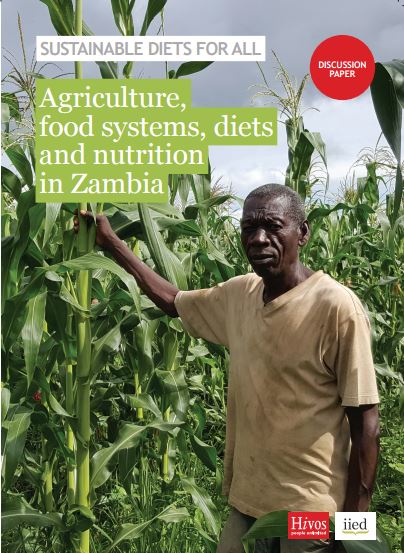Zambia needs to rethink its food and agriculture system in order to improve diversity in both food production and consumption, according to the new report “Sustainable Diets for All: Agriculture, food systems, diets and nutrition in Zambia”. The report finds that every US dollar of investment in proven nutrition interventions could potentially generate around USD18 in economic returns from improved health and productivity of the population.
Published by IIED and Hivos, the report states that despite government policy aimed at improving food and nutrition security, Zambia’s food and agricultural system is providing neither food security nor adequate nutrition for all.
In Zambia as elsewhere, agricultural production is focussed on one staple cereal: maize. According to the report, maize constitutes the major part of the food energy supply in Zambia, while nutrient-rich foods such as legumes, animal-source foods and fruits and vegetables are only minor contributors.
As a result, the diets of most Zambians are poor, and many live with food insecurity and malnutrition as a result: seasonal hunger still affects many families; a significant proportion of children still suffer from stunted growth; and overweight and attendant diseases are increasing in adults. What connects the issues of hunger, malnutrition and chronic disease is the year-round availability and accessibility of diverse foods for healthy and sustainable diets.
Rural Zambian diets in particular are characterised by monotony and periods of seasonal scarcity, and modern Zambian agriculture relies on a limited number of non-indigenous crops and limited diversity among different food groups.
According to the report, the introduction of maize to Zambia before colonial times, and its promotion as an aspirational crop by the colonial government, resulted in a gradual shift away from the consumption of indigenous crops like millet, sorghum and cassava – to the point that today, these traditional staples are marginalised by maize.
“Traditional diets based on nshima (maize meal porridge) are still preferred by most Zambians, providing meals that are high in starches and generally low in nutrients. Accompanying dishes (known as ‘relishes’) change throughout the year by season, but the consumption of indigenous vegetables has also declined, in favour of a narrow selection of introduced varieties,” states the report.
“Related to its monotonous and deficient diets, Zambia has unacceptably high levels of child undernutrition. In Zambia, 40.1 per cent of children under five are suffering from stunted growth in height – a manifestation of chronic undernutrition,” states the report.
The report also emphasizes that lack of diversity is bad for diets, resulting in micronutrient deficiencies, child stunting and adult obesity; and bad for agriculture, resulting in a lack of resilience in food systems.
Returns on investment are likely to be high, with diverse agriculture creating more resilience and fewer losses to pests. The report makes key recommendations to improve the state of Zambia’s food systems:
First, research and development plays an important role in fostering innovation, diversity and productivity in agriculture and is an important first step in longer policy change initiatives. There is need for increased investments in agricultural research and development, specifically in the area of improved seed for foods that are both nutritious and commercially viable, and in localised seed multiplication to improve availability.
Second, agricultural extension services must focus more on improved diets and nutrition through improved training and gender-sensitivity in the agricultural workforce.
Third, Zambia can leverage the e-voucher system for agriculture and dietary diversity by training agro-dealers, and ensuring a diverse supply of inputs for farmers.
Fourth, the Zambia government needs to formulate deliberate strategies that support smallholders by ensuring that food security programmes and input access are targeted to those who need them most.
Fifth, there is a need to increase consumer demand for diversity to increase the purchase and production of diverse foods.
Sixth, Zambia needs to promote value chains for nutrition to encourage nutrition and economic value addition along the food chain. Explicit attention is required to the production, processing, and marketing of nutritious foods needed for diverse diets.
Seventh, Zambia needs to invest in collecting food procurement and consumption data of its population to better understand emerging dietary patterns. Representative food consumption data covering both household procurement (where households buy or obtain food) and individual diets (what different household members are eating) are critical to creating effective food security and nutrition policy and dietary guidelines, and for agricultural sector plans to respond to changes in demand.




